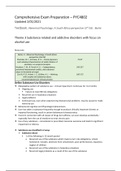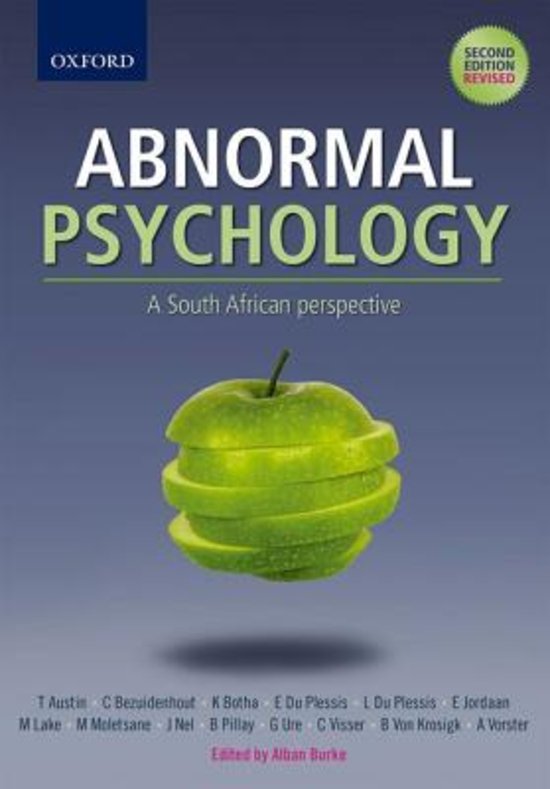Comprehensive Exam Preparation – PYC4802
Updated 2/01/2021
Textbook: Abnormal Psychology: A South Africa perspective (3rd Ed) - Burke
Theme 3 Substance related and addictive disorders with focus on
alcohol use
Resources:
Burke, A - Abnormal Psychology: A South Africa
perspective (3rd Ed)
Sheridan, M. J., & Green, R. G. – Family dynamics 73-97
and individual characteristics of adult children of
alcoholics: an empirical analysis
Knudson, T. M., & Terrell, H. K. – Codependency, 245-257
perceived interparental conflict, and substance
abuse in the family of origin
Cox JR, R. B., Ketner, J. S., & Blow, A. J. – Working 160-172
with couples and substance abuse:
recommendations for clinical practice.
Define Substance-Use Disorders
❖ Maladaptive pattern of substance use – clinical impairment. Continues for >12 months
➢ Ongoing use
▪ Failure to meet NB role obligations
➢ Recurrent use in hazardous situations
➢ Legal problems
➢ Continued use, even when experiencing interpersonal problems- may be caused or made
worse by use
❖ Behavioural cognitive and Physiological phenomena
❖ User has taken a substance frequently enough to produce clinically important distress or
impaired functioning, result in certain behavioural characteristics
❖ Found in connection with all classes of drugs but caffeine, can even develop accidentally –
especially from the use of medicine to treat chronic pain
❖ Use of any substance – recreational or prescribed- becomes excessive and leads to significant
impairment or distress
❖ Substance use classified in 2 ways
➢ Substance abuse
▪ 1 of the following in 12-month period
• Recurrent use of the substance which impairs one’s role obligations- school
homework. includes. absences from school/work, poor performances, expulsion,
neglect of children
• Recurrent use of the substance in hazardous situations
• Recurrent legal problems as a result of the use of the substance
, •
Continuing use despite the fact that it is resulting in recurrent social and
interpersonal problems includes. spousal conflict
➢ Substance dependence
▪ At least 3 of the following in a 12-month period
• Tolerance- need increasing amounts of the substance to achieve intoxication or
there are diminishing effects of the substance
• Withdrawal- withdrawal symptoms on discontinuation of the drug or takes the drug
to avoid the withdrawal symptoms
• Often takes more of the substance than intended, or takes it for longer than
intended
• Persistent desire or unsuccessful attempts to cut down or control use
• A great amount of time is spent obtaining using or recovering from its effects
• Impairment in social occupational or recreational activities
• Continued use despite knowledge that it causes physical or psychological problems
DSM-5 diagnostic criteria for Alcohol Use Disorder
(APA, 2013, pp.490-491)
A. A problematic pattern of alcohol use leading to clinically significant impairment or distress, as
manifested by 2 (or more) of the following, occurring within a 12-month period:
1. Alcohol is often taken in larger amounts or over a longer period than was intended.
2. There is a persistent desire or unsuccessful efforts to cut down or control alcohol use.
3. A great deal of time is spent in activities necessary to obtain alcohol, use alcohol, or
recover from the effects.
4. Craving, or a strong desire or urge to use alcohol.
5. Recurrent alcohol use resulting in a failure to fulfil major role obligations at work, school,
or home.
6. Continued alcohol use despite having persistent or recurrent social or interpersonal
problems caused or exacerbated by the effects of alcohol.
7. Important Social, occupational, or recreational activities are given up or reduced because
of alcohol use.
8. Recurrent alcohol use in situations in which it is physically hazardous.
9. Alcohol use is continued despite knowledge of having a persistent or recurrent physical or
psychological problem that is likely to have been caused or exacerbated by alcohol.
10. Tolerance, as defined by either of the following:
a. A need for markedly increased amounts of alcohol to achieve intoxication or
desired effect.
b. A markedly diminished effect with continued use of the same amount of
alcohol (Note: Tolerance is not counted for those taking medications under
medical supervision such as analgesics, antidepressants, ant-anxiety
medications, or beta-blockers.)
11. Withdrawal, as manifested by either of the following:
a. The characteristic withdrawal syndrome for alcohol (refer to Criteria A and B
of the criteria set for alcohol withdrawal, pp. 499-500).
b. Alcohol (or a closely related substance such as a benzodiazepine) is taken to
relieve or avoid withdrawal symptoms.
(Note: Withdrawal is not counted for those taking medications under medical supervision
such as analgesics, antidepressants, anti-anxiety medications or beta-blockers.)
Specify current severity:
Mild: Presence of 2-3 symptoms.
Moderate: Presence of 4 to 5 symptoms
Severe: Presence of 6 or more symptoms





